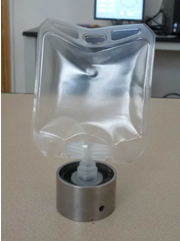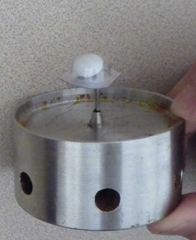In the past, barrier property testing was only for films, which has brought great inconvenience to end package manufacturers and users. Most raw materials they bought could make barrier property testing, but the finished packages, owing to the lack of testing techniques, would bring hidden dangers to end-product quality. The difficulty for testing lies in the varied shapes of packages. However, owing to the promotion of barrier property testing, integral package barrier property testing has made great progress with more kinds of testable packages. This article makes a detailed introduction on the development of integral package barrier property testing and relevant testing cases.
Keeping certain shapes is the most basic characteristic for packages. Therefore, keeping the package intact is the first thing when testing. Secondly, the seal performance of testing instruments and sampling accessories should be guaranteed. Those two points are difficult to achieve for package testing, compared with film and sheet testing.
The testing principles of equal pressure method oxygen transmission rate for both films and packages are similar. First, the preconditioned specimen separates the transmission chamber into two separate gas flow systems. Testing gas flows in one side of the package, such as pure oxygen or mixed gas with oxygen; high pure carrier gas flows in the other side. Though the gas pressure of two sides are the same, oxygen sub-pressures are different. Therefore, under the gradient of oxygen concentration, oxygen transmits through package and is carried to the sensor by the carrier gas. The sensor will measure the oxygen quantity in the carrier gas flow precisely, so as to work out the oxygen transmission rate of the tested package. If only specimen preparation issue can be effectively resolved, various packages are testable by this method. Testing subjects can be the integral package or a part of it, including various bottles, the connecting part of bottle cup and bottle body, bottle cup, capsule, blister, tube, injection, IV bags, flexible pipe and various ball-shape packages. Besides, the contents of tested packages can be in or not, so as to provide most reliable data for package evaluation in actual application and quality change of contents.
At present, ASTM F 1307 is the only testing standard for equal pressure method, and is applicable for all packages that can produce dry spaces inside. Moreover, equal pressure method oxygen transmission rate testing techniques can also be used under humid circumstances, and can further provide an environment with certain humidity in or out side the package.
Keeping the package shape intact is the main difficulty for differential pressure method package gas transmission rate testing. Owing to the pressure difference between the inner and outside of the package, the tested specimen might be destroyed by pressure difference without appropriate means to keep its shape, and result in meaningless testing results, or even no testing data. At present, in the field of differential pressure method gas transmission rate testing research, Labthink has made breakthrough. At the same time, Labthink has successfully extended integral package gas transmission rate testing from oxygen alone to many common inorganic gases. However, there are not many kinds of subjects can be tested with this method.
Weighing method water vapor transmission rate testing is the traditional method for package water vapor transmission rate testing; the relevant testing methods are: GB/T 6981-1986, GB/T 6982-1986 and ASTM D 3079-94. The testing process is as follows: first, put the desiccant (container is permitted) into the specimen, and seal the open place on the package wall. After preheating, put the specimen into the testing chamber with constant humidity and constant temperature for humidity and temperature test. Then, weigh the weight of the specimen at proper intervals according to the water vapor transmission performance of the package. When the transmission reaches stability, calculate the integral package water vapor transmission rate on the added weight of the specimen. However, open a mouth on the package wall is not practical, and it would always lead to operational failure and corresponding failure. Therefore, in the standards for pharmaceutical packaging materials, the desiccant is changed into distilled water or other testing solvents when using this method. Thus, there is no need to open and close the package mouth repeatedly; and the only thing needs to do is to weigh the package at certain intervals. However, the long testing periods and precision limit are the inherent shortcomings of this method.
Sensor method and different pressure method package water vapor transmission rate testing techniques are similar in the testing principle: separate the transmission cell into two isolated gas flow system by the package, one side of the package flows the carrier gas (dry); and another side is in a relative humidity. Thus, a stable water vapor concentration difference exists between the two sides of the specimen (relative humidity). Under the influence of water vapor concentration difference, water vapor transmits through the package wall and is carried to the sensor. The sensor measures the water vapor content in the carrier gas accurately so as to further calculate water vapor transmission rate of the specimen. This method is applicable for bottles, pouches, capsules, blisters, IV packages, flexible pipes and other forms of packages. Now, the testing accuracy of this method is up to 0.001g/pkg·d; the testing period is only 3 to 4 days; and the testing process is completely automatic.
Usually, package barrier property testing is for bottles or certain parts of the bottle. However, package is not limited to bottle, pouches, flexible pipe and PVC trays also have broad applications, among which, the testing for pouches and small-sized package (e.g., blister) are more emphasized.
The space maintenance of the pouches should be taken care of when using equal pressure method or sensor method. As to pouches, if the pressures inside and outside can not be well controlled, it would result in less gas transmission area and lead to data error. Therefore, the pouches should be bulged during precondition period, and it can be achieved by putting certain quantities of gas or other accessories into the pouches. At the same time, the space inside pouches should also be kept during testing process so as to avoid shriveling, especially for thin food pouches. As to IV bags, jelly pouches, stand up pouches and other thick pouches, their shriveling probability is less.
When using weighing method, how to keep the space inside the pouches is also a problem. Meanwhile, how to seal pouches after filling distilled water inside should also be considered, which increase the difficulty in actual operation.

Blisters are usually of small volume. Therefore, they can only be tested by equal pressure method or sensor method. Furthermore, the specimen preparation can only be accomplished with customized accessories. Meanwhile, the adjustment of flowing speed during testing process should also be cautious so as to avoid sudden pressure increase and decrease caused by violent change of gas quantity, and thus, avoid influences to the specimen status.
Usually, the testing accessories for blisters are also applicable for small-sized package testing, such as capsule; and can expand to more kinds of small-sized packages conveniently.

The development of integral package barrier property testing techniques has greatly expanded the scope of barrier property testing. Now, the testing subjects have expanded to nearly all the packages, which have brought fundamental testing reform for package manufacturers and users. Meanwhile, with the leak and seal testing as well as headspace gas analysis, a more integral, effective and accurate package result can be guaranteed.